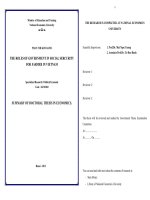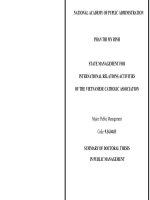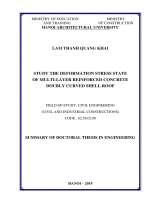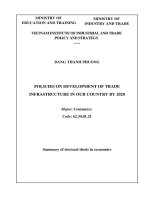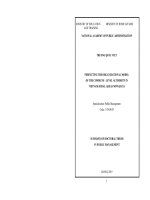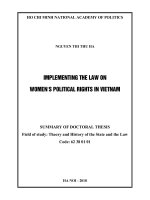Summary of Doctoral thesis in Geography: Study on soil geomorphology for planning and using land sustainably in Bac Tay Nguyen region
Bạn đang xem bản rút gọn của tài liệu. Xem và tải ngay bản đầy đủ của tài liệu tại đây (14.05 MB, 30 trang )
MINISTRY OF EDUCATION
AND TRAINING
VIETNAM ACADEMY OF
SCIENCE AND TECHNOLOGY
GRADUATE UNIVERSITY OF SCIENCE AND TECHNOLOGY
-----------------------------
NGUYEN VAN DUNG
STUDY ON SOIL GEOMORPHOLOGY FOR PLANNING
AND USING LAND SUSTAINABLY IN
BAC TAY NGUYEN REGION
Major: Geography of Resource and Enviroment
Code: 9 44 02 20
SUMMARY OF DOCTORAL THESIS IN GEOGRAPHY
Hanoi - 2018
The thesis is completed at: Graduate University of Science and
Technology, Vietnam Academy of Science and Technology.
Supervisors: 1. Ph.D. Nguyen Đinh Ky
2. Assoc. Prof. Ph.D Nguyen Dich Dy
Reviewer 1: ………………………………………………
Reviewer 2: ………………………………………………
Reviewer 3: ………………………………………………
The thesis will be defended at Graduate University of Science and
Technology - Vietnam Academy of Science and Technology, at hour
……date……month ……201...
Thesis can be found in
- The library of the Graduate University of Science and Technology
- Vietnam’s National Library
INTRODUCTION
1. The necessity of the research
Soil is a precious natural resource that most food supply to human
are derived from. V.V.Docutraev supposed that soil is an
independent natural object, formed by the interaction of parent rock/
matter, terrain, climate, organisms and time factor. These
relationships are deeply researched into such directions: soil
geomophology, soil-parent rock/material, soil-climate, soilorganisms...In that the relationship of landforms and soils are
considered the most dynamic and complex; can be explained on the
basis of the balance between morphogenesis and pedogenesis.
In the organization of production and land use, the characteristics
of the morphopedological (MP) landscape are important for
economic efficiency and sustainability because using land, changing
vegetation triggers exogenous processes (morphogenesis) to affect
the soil cover, making it change. If the land use is suitable with the
rules of morphogenesis and pedogenesis, it is sustainable and
effective. If not, it is not sustainable and ineffective, leading to land
degradation - desertification.
Bac Tay Nguyen (BTN) region accounts for about 50% of the
total area of Tay Nguyen, including Kon Tum and Gia Lai, which
has a wide variety and diversity of soil types. It has most of groups
and major soil types of Tay Nguyen. With the characteristics of
morphopedology of mountains, high plateau, always implies the
process of natural hazards such as land degradation, landslide, floods,
drought ...
For the above reasons, the project "Study on soil geomorphology
for planning and using land sustainably in Bac Tay Nguyen region"
have been made in order to contribute to the solutions of the practical
requirements and sustainable development of Tay Nguyen.
2. Research objectives
Establishment of morphopedological units as scientific basis for
planning and using land sustainably in Bac Tay Nguyen region
3. Research implementations
- Overview of researchs of soil geomorphology in domestic and
foreign;
- Establishing theoretical basis for research of soil geomorphology
- Analyze the conditions that make up the MP landscapes in BTN
1
- Build the system of classification, criteria and establishment of
MP map of Bac Tay Nguyen at the rate of 1/ 250,000;
- Analyze the morphopedological landscapes (MPL) in BTN
- Analyze, assess the MP landscapes for land use in Bac Tay Nguyen
- Proposing solutions for sustainable land use and management
from morphopedological approach in Bac Tay Nguyen.
4. Research area and object
- Research area: Bac Tay Nguyen, including Kon Tum and Gia Lai.
- Research object: geomorphology, soil in Bac Tay Nguyen region.
5. Protected points
- Correlations of geomorphology and soil in Bac Tay Nguyen are
presented characteristics, morphology of terrain and pedology, based
on morphogenesis and pedogenesis in the MP landscapes.
- Bac Tay Nguyen is divided into 12 groups, 39 types of
morphopedological landscapes, which are diverse and complex, so
planning and using land must follow this division to achieve
sustainable development and disaster prevention.
6. New points
- The thesis is the first one to assess the relations of geomorphology
and soil in Bac Tay Nguyen and present the relations on
morphopedological map with scale 1/250.000.
- Initially proposed a plan for spatial organization, planning and
using land sustainably, simultaneously warning of natural disasters
based on the analysis of characteristics, structure of
morphopedological landscap in Bac Tay Nguyen region
7. Scientific and practical contributions
- Scientific contributions: contributing to the clarification of soil
and geomorphology relationships in the tropics; and improvement of
the MP method for planning, sustainable use of land resources.
- Practical contributions: The result of the project is the scientific
basis for planning, territorial organization, sustainable use of natural
resources and natural disaster prevention; It is also important data for
soil survey and land assessment. Viewpoints and methods of the thesis
can be applied for Tay Nguyen and other areas with similar conditions.
8. The structure of the thesis
Apart from the introduction, the conclusions and
recommendations, reference and appendix, the thesis consists of 3
chapters:
2
Chaper 1. Theoretical basis and research methods of soil
geomorphology in Bac Tay Nguyen
Chaper 2. Conditions of formation and characteristics of
morphopedological landscapes in Bac Tay Nguyen
Chaper 3. Assessment of morphopedological landscapes for
planning and using land sustainably in Bac Tay Nguyen
Chaper 1. THEORETICAL BASIS AND RESEARCH
METHODS OF SOIL GEOMORPHOLOGY IN BAC TAY
NGUYEN
1.1. Theoretical basis of soil geomorphology
1.1.1. Science of soil geomorphology
Each geomorphologic surface is determined by landform, age,
parent rock/material and the process of forming landform.
Geomorphology accounts for three factors in the five soil forming
factors. Therefore, soil geomorphology is mainly focused on
studying the relationship of these geomorphologic characteristics
with soil and morphogenesis with the pedogenesis.
In the perspective of geomorphology and soil, J. Tricart (1965)
theo A.J. Gerrard (1992)..., soil geomorphology is to research the
relationship of geomorphology and soil, the processes of formation
and development. It is to study the relationship of soil development
with the forming factors.
Moreover, soil geomorphology is an important research method in
re-establishing the ancient geographic environment (Gerrard, 1992;
Birkeland, 1999).
1.1.2. Overview of researchs of soil geomorphology
1.1.2.1. Overview of researchs of soil geomorphology in foreign
The relationship between relief and soil is researched very early
in the late 19th century by Russian scientists, typically V.V.
Docuchaev who studied on determining soil related to relief in small
territories. N. M. Xibirtxev (1900) developed the theory of combine
and structure and soil cover, and emphasized the terrain in creating
soil combination. X.X. Neuxtruev (1910) raised the law of evolution
and developed soil combinations corresponding to the terrain
development stages of V. Davis' diagram of terrain development .
3
During the surveys in eastern Africa, Milne (1935) discovered a
sequence of soil types repeated in space related to relief change, and
brought the theory of soil catena.
Clarke (1954) classified the soil catena into three categories: the
drainage catena, the geological catena and mixed catana.
In the research of relationships of soil and topography, Boulaine
(1966) and Aubert (1967) divided into soil chains where the soil
components related to the forming relationship; the ranges of soil
where the soil components have a very weak forming relationship.
Analyzing the relationship between morphogenesis and
pedogenesis, J. Tricart (1965, 1977) discovered that it was the
transformation of the balances between these two processes that
caused different types of soil sequences releated relief. The author
gived the concepts of truncated soil, buried soil, multi-phase soil.
Fridland VM (1972) studied and divided the soil structure into 6
types of soil combination: soil combin, multi-temporal soil combin,
soil complex...
Kilian (1972) used morphopedological method to build MP map
with basic principles for general research.
G. Bourgeon (1989) sketched MP landscapes directly from
satellite images to create a reconnaissance soil map at a scale of 1:
1,000,000 for a wide area of peninsular India. R. Poss (1996) created
a morphopedological map for northern Togo.
François Bétard, Gérard Bourgeon (2009) used the
morphopedological method to analyze geomorphology and soil in
northern Brazil.
1.1.2.2. Overview of researchs of soil geomorphology in domestic
Research on soil geomorphology in Vietnam is not much, has
been mentioned since the 1990s and back, mainly typical research
applications such as Dao Dinh Bac (1997, 1998), Nguyen Dinh Ky,
Vu Ngoc Quang, Dao Dinh Bac, Bourgeon (1995-1999), Nguyen
Van Dung (2014-2016).
1.1.3. Viewpoint of morphopedological landscape and its elements
Morphopedological landscape is sequence of the soil types,
groups on the surface unit of the terrain, is formed on the basis of the
balance of morphogenesis and pedogenesis. This concept coincides
with catena, soil combime. Moreover, the concept of
4
morphopedological landscape is different from the concept of
landscape that Vietnamese geographers still use.
Elements of soil cover in a morphopedological landscape include
residual soil, truncated soil, (buried) deluvial soil, deposited soil.
They are arranged with slope rules from the summit, upper slope,
lower slope and valley; they make up the corresponding
morphopedological units.
1.1.4. Factors affecting on landform and soil
Morphopedological landscape reflects the relationship between
terrain and soil in their formation, development; and in relations to
the factors of parent rock/material, climate, organism, human activity
and time.
1.1.4.1. Parent rock/material: provides the original material that
forms the terrain and soil. It has different origin and petrographic
composition that has different weathering rate and makes different
characteristics of types of topography and soil.
1.1.4.2. Time: determines the grade of development of terrain, soil
and their relationship, thus affects on their characteristics.
1.1.4.3. Climate, hydrology: Climate influences directly on
topography and soil through rock weathering processes,
morphogenesis, pedogenesis or indirect effects through impacts on
fauna and flora systems. Moreover, the characteristics and shapes of
the hydrological network reflect the geological structure,
characteristics and the dissection of terrain and soil.
1.1.4.4. Creature: Flora plays a major role in transforming
weathering layer into soil cover and creating fertility through the
supply of organic residues, humus. It affects on maintaining of stable
conditions of heat, moisture, and water retention capacity; and
maintaining the balance of morphogenesis and pedogenesis.
Moreover, vegetation type and growth rate are indicative of soil
cover and a measure of soil productivity.
1.1.4.5. Human activity: Humans have a profound influence on
relation of geomorphology and soil through vegetation change,
mechanical impact on terrain and soil by farming practices and land
use; or the construction of civil works...
1.1.5. Relationship between landform and soil in Bac Tay Nguyen
On the slope surface, formation of a soil model of catena,
reflecting the regular sequence of residual soil, truncated soil, buried
5
soil and deposited soil, corresponding from the summit, upper slope,
lower slope to valley.
The relationship between geomorphology and soil is presented in
morphogenesis and pedogenesis, as follows: 1) Where there is strong
morphogenesis, typically MP landscape of moutain has a strong
erosion, and thin, truncated soil and buried soi. 2) Where there is
weak morphogenesis, weathering crust and soil cover are thick,
typically MP landscape of plateau on basalt has a weak erosion and
thick residual soil. 3) Where there is moderate morphogenesis,
typically MP landscape of sloping plateau, hill has moderate erosion
and thick semi-residual, or residual soil.
In the plain, valleys, the formation and development of soil cover
is based on the balance between sedimentation and the feralit,
tropical podzol. It is the basis for the formation of plain soil cantena
that reflects alluvial sequence of yellow brown or gray soil, patchy
color soil, deposited soil on the highest terraces to the lowest one.
The terrain distributes heat, humid conditions through the effects
of elevation that forms altitude laws for geographic components
including soil cover.
Elevation and situation of terrain redistributes of geochemical
elements through the movement of flow and groundwater that
changes on the soil characteristics. In addition, direction of terrain
affects directly or indirectly through factors that form soil.
1.1.6. The forming process of MP landscapes in Bac Tay Nguyen
1.1.6.1. Pedogenesis: include feralit, laterit, sialit, decomposition and
humification, tropical podzol, and gley.
1.1.6.2. Morphogenesis: erosion, erosion of flow and sedimentation.
1.2. Theoretical basis for the establishment of MP map
1.2.1. An overview of the classification system of MP landscape
Typically the classification system of the French scientists and the
classification system of the Australian scientists.
1.2.2. Classification system of MP landscape for Bac Tay Nguyen
The classification system is based on the origin of landform,
especially the dynamics of its formation and the arrangement of soil
elements with rules on the slope surface. In this study, the author
selected a three-grade classification system, including group, subgroup and type of MP landscape, with a scale of 1/250,000, of
which: 1) MP group is formed on the basis of correlation between
6
landform type and soil cover; 2) MP sub-group is formed on the
basis of the correlation between morphogenesis with soil cover; 3)
MP type is formed on the basis of the correlation between parent
rock/material with soil cover in relation to the type and sub-type.
1.2.3. Criteria for the classification of MP landscapes
The classification of MP landscape at group grade is based on
correlation between types of landform and soil cover. The
classification of landform is shown in Table 1.8.
Table 1.8. Criteria for the classification landform
Morphological characteristics
No
1
2
3
5
6
Landform
Plain
Semi-plain
Low hill
High hill
Low plateau
Medium plateau
8
High plateau
9
Low sloping plateau
10 Medium sloping plateau
11 High sloping plateau
7
12
13
14
16
Low mountain
Medium mountain
High mountain
Valley
Slope
Elevation (m)
< 30
< 50
5-150
5-150
< 50
Relief
intensity (m)
< 10
10 - 25
25 - 100
100 - 150
< 50
< 50
< 50
1000 - 2000
0
<5
< 500
< 500
< 100
< 500
500 - 1000
< 50
> 2000
5-150
50 - 150
500 -1000
5-15
0
50 - 150
1000 - 2000
5-15
0
50 - 150
> 2000 m
5-15
0
> 150
500 - 1000
> 15
0
> 150
1000 - 2000
> 15
0
> 150
> 2000
<3
0
< 10
Moreover, the division of landscapes of semi-arid
morphopedology are based on the climatic characteristics and the
occurrence of soil groups representing semi-arid climate such as gray soil,
dark brown soil that satisfy criterion of Lixisols, Luvisols or Phaeozems.
Morphopedological landscape division is based on the
differentiation of soil cover with the dissection of terrain and the
proportion of deposited soil in the valley.
1.2.4. Procedure of the establishment of morphopedological map
7
Establishing the morphopedological map of Bac Tay Nguyen is
done according to the procedure of Figure 1.4.
Figure 1.4. Procedure of the establishment of MP map
1.3. MP basis for planning and using land sustainably
1.3.1. Relationship morphopedological landscape and planning,
using land sustainably: land use and vegetation play an important
role in maintaining the balance of morphogenesis and pedogenesis.
This balance is prone to morphogenesis; increased natural disasters
cause land degradation and unsustainable ecosystems. This balance
is prone to pedogenesis; mitigated natural disaster that lead to stable
soil fertility for high biological productivity, sustainable ecosystem.
1.3.2. Assessment of MP landscape for planning, using land
sustainably
Assessment of morphopedological landscape is the consideration
of the characteristics of the MP landscape that are relevant to the
ecological needs of the types of land use; and the consideration
whether the current land use is appropriate or not to change the plan of
land use in order to achieve the goal of sustainable development.
In the appropriate ranking of morphopedological landscape, PhD
student uses the most restrictive principle, if it has superior factor
that is the maximum limit, it is ranked by the level of the factor.
1.3.3. Tolerance of soil erosion: In this study, value of 5
tons/ha/year is used for tolerance of soil erosion.
8
1.3.4. Agroforestry: is a spatial model of sustainable production for
the hills and plateaus.
1.3.5. Territorial, spatial organization: in this study, it is based on
morphopedological landscape that show the relationship between
soil, terrain and the forming spatial factors. The arrangement of land
use types on different scales is based on various grades of MP
landscape from the high to low in order to obtain the most high
society of economy, society and environment.
1.3.6. Land use planning: In the morphopedological approach, land
use planning is a process of assessing potential MP landscapes,
making decisions, and taking action in dividing the MP landscapes
for use needs to provide the most profitable, and secure future needs.
1.4. Viewpoint and methodology
1.4.1. Viewpoint: perspective of integrate and system, historical
perspective, ecological perspective, sustainable development
perspective and land degradation perspectives.
1.4.2. Methodology: morphopedological methods, field survey
methods, method of mapping, remote sensing and GIS, method of
quantitive assessment of soil erosion and sample analysis methods.
1.5. The research steps of the thesis
Figure 1.5. Diagram of steps to implement the project
9
Chapter 2. FEATURES OF MP LANDSCAPES AND THEIR
FORMING CONDITIONS IN BAC TAY NGUYEN
2.1. Forming conditions of MP landscapes in Bac Tay Nguyen
2.1.1. Geographical location
Bac Tay Nguyen region is located in the coordinates from
13055'10" to 14°36'30"N and from 107°27'23" to 108°54'40"E.
covers an area of 2.522.653 hectares, includes two provinces: Kon
Tum and Gia Lai. It stretches north-south, small in the north, large in
the north. The mountain in the east causes the foehn that make up the
difference between the climate of the region and Duyen Hai Nam
Trung Bo.
2.1.2. Geological conditions
BTN has a variety of parent rock/material from Quaternary
formation to Ackeozoi formation, a variety of origin from
sedimentary, metamorphism to intrusive igneous magma, extrusive
igneous magma. They are complicated by the process of tectonics
and denudation. Based on the composition and the origin of geology,
it is divided into 8 main groups of parent rock/material.
2.1.3. Conditions of landform
Bac Tay Nguyen is a system of mountain, sloping plateaus high
valleys and plains. The alpine system is in the east and gradually
descends to the west. It has a bow shape, the convexity is facing east,
and embraces the plateaus and plains in the west.
2.1.4. Conditions of climate
The area is also affected by tropical monsoon climate, and has the
nature of cool plateau-climate. Annual average temperatures range
from 170C to 270C. Annual average rainfall ranges from 1,200 to
2,800 mm. Due to the influence of the terrain, the climate changes
markedly in the direction of north-south. There are three types of
climate: the tropical climate of the high mountains in the north,
gradually moving into the tropical plateau-climate, and the semi-arid
tropical climate in the south.
2.1.5. Conditions of hydrograph
The network of rivers and streams are relatively developed, its
erosion in this place is strong, water divides is very complex. The
river network of the area is closely related to geological structure and
fault systems. It has large river systems such as Song Ba, Se San, Po
Ko and Dak Bla.
10
2.1.6. Vegetation characteristics
The vegetation covers the following types: broad-leaved
evergreen forest; broad-leaved deciduous forest; coniferous forest;
needle, broadleaf-mixed forest; bamboo, broadleaf-mixed forest;
bamboo forest; plantation forest; shrub; shifting cultivation; wet rice;
and perennial crops.
2.1.7. Human activities
The increase in mechanical population over the years has put
pressure on the resources and environment - the large need to use
land for socio-economic development. Most of the area has been put
into use, of which the agricultural land group is 2,268,822 ha,
accounting for 89.94% of the natural area, including agricultural
production land is 1,066,374 ha and forest land is 1,199,881 ha; Nonagricultural land is 147,385 ha, accounting for 5.84% of the natural area;
and unused land is 102,941ha, accounting for 4.08% of the land area.
2.1.8. Characteristics of soil cover
It has 9 soil groups of 24 soil types which show the interrelation
of the zonal and azonal laws, closely related to the formation
conditions. The zonal soil group includes the reddish-yellow feralite
soil, the reddish-brown feralite soil, and the semi-arid gray soil that
characterizes the arid climate; Alluvial soil, gley soil, black soil, thin
soil shows the azonal law; and red feralite humus soil and reddish
brown feralit soil show the high altitude law.
2.2. Features of MP landscapes in soil Bac Tay Nguyen
Based on the relationship of geomorphology and soil, their the
forming factors, selecting the classification system suitable for the
study area, the PhD student conducted MP mapping at a scale of
1/250,000 with the classification criteria system and mapping
process established. Nature characteristics in Bac Tay Nguyen are
shown in 12 groups and 39 types of MP landscapes. In that the
relationship between geomorphology and soil are reflected.
2.2.1. MP landscape of medium mountain
It is distributed mainly in the Ngoc Linh mountain range. Due to
the dominant denudation process, the high elevation that corresponds
to the landform of medium mountain are soil combine of humus
feralite. It includes two main elements: thin truncated soil on upper
slope and deluvial soil (thicker and more humus) on lower slope.
They satify Umbric Leptosols or Umbric Cambisols. Moreover,
11
deluvial soil element on more dissected mountain accounts for a
bigger proportion than that on less dissected one, and soil cover
changes with magma acid and metamorphic rock, these form 4 MP
landscape types: KJ, KIJ, KA và KIA.
2.2.2. MP landscape of medium sloping plateau
It is distributed in Kon Ha Nung and Kon Plong. Sloping plateau
is the result of the peneplanation in ancient geography, has thick
weathering cover and strong pedogenesis; Moreover, due to high
elevation, that is advantageous to form humus semi-residual and
residual soil with profile development such as: humus reddish-yellow
feralite soil that satisfy Humic Acrisols or Humic Ferralsols. Most of
the landform is dissected, has the structure of hills and hollows, and
formed on magma acid and metamorphic rock, soil cover is various
with that conditions, reflected in two MP landscape of OHJ and OHA.
2.2.3. MP landscape of medium plateau on basalt (OZ)
It is distributed in Kon Plong and Kon Ha Nung, formed on basalt
rocks with Neogene age, has a thorough weathering process for
thick weathering layer and soil cover. The soil is reddish brown,
granular structure, texture of medium loan. Corresponding to
medium basalt plateau is a residual soil combine of reddish brown.
However, medium plateau is divided into the summit surface with a
height of 1100-1400 m, dissected shallowly; upper surface with the
height of 900-1100 m dissected deeply; and the lower surface at a
height of 600-900 m, dissected shallowly; soil cover vary with those
surfaces, presented in the MP landscape of OZ1, OZ2, OZ3.
2.2.4. MP landscape of low mountain
It is distributed in Sa Thay and Mang Yang. This MP landscape
has the dominant process of erosion and continuous rejuvenation so
the soil is often thin, has much rock fragments. Corresponding to low
mountain is reddish-yellow soil combine of feralite, which includes
two main elements: thin truncated soil on upper slope, thicker
deluvial soil on lower slope. They satisfy Leptosols or Cambisols.
Deluvial soil element on more dissected mountain accounts for a
bigger proportion than that on less dissected one; moreover, soil
cover changes with forming rock, present in 3 MP landscape of NIJ,
NJ and NA.
2.2.5. MP landscape of low sloping plateau
12
This MP landscape is distributed from Ngoc Hoi to Sa Thay. It is
formed the ancient landform, has thorough weathering process and
high pedogenesis, which lead to thick weathering crust and soil cover.
Corresponding to stable environment of sloping plateau in long
time is semi-residual and residual soil with profile development such
as: yellowish-red soil combine of feralite, satisfying Acrisols; and
reddish-brown soil combine of feralite, satisfying Ferralsols.
In heavy rain conditions, most of sloping plateau is much
dissected, has structure hills and hollows. Soil cover changes with
the structure, present in 4 landscape of CHJ, CRJ, CHA, CRA.
2.2.6. MP landscape of low plateau (CZ)
MP landscape of CZ is distributed widely Gia Lai province and
Kon Tum town. Due to the characteristics of basalt, the weathering
process is thorough, so weathering crust and soil cover is thick, relief
is smooth. That is favorable conditions for forming groundwater rich
in Fe2+, Al3+. Fluctuations of groundwater, capillary process,
influence of altitude laws create a change of lateritic process in the
position of plateau surfaces: the fairly flat summit surface with a
height of 700-850 m, the deeply dissected upper surface with a
height of 500-800 m, the dissected lower surface that is a height of
300-600m has laterite, the foot of plateau that is a height of 300350m has laterite. Moreover, contact plateau of basalt is thin.
Residual soil vary accordingly, is presented in 7 MP landscape of
CZ11, CZ12, CZ21, CZ22, CZ31, CZ32, CZ4.
2.2.7. MP landscape of high plain and valley
It is distributed from Ngoc Hoi to Kon Tum town. This MP
landscape is formed on accumulation products of Po Ko river system
The characteristics of the soil cover are varied according to the river
terrain and the origin of deposited sediment, presented in two MP
landscape of TP and Tt.
2.2.8. MP landscape of hill
Most of hill is formed by pediment. Corresponding to medium
pediment hill is soil combine of truncated soil, deluvial soil. Most of
the relief is dissected and has structure hills and small hollows or
large hollows. Soil cover changes corresponding to the structure, is
presented in MP landscape of DRA and DHA.
2.2.9. MP landscape of semi-arid low mountain
13
It is located in mountainous area of Chu Trian, Chu Dju and is
scattered in the south of the study area. In the semi-arid tropical
climate, at the foot of the mountain the process of feralite weathering
is weak, when rising, the humidity increases but the average
temperature decreases. This make the feralite process still weak.
Combined with the impact of gravity, the flow of matter moves along
the slope. The advantage of erosion process makes the soil layer thin
and rejuvenate continuously. Therefore, the soil cover is often thin,
much rock fragment and dominated by a thin soil combination of
reddish-yellow feralite. They satify Leptosols or Cambisols.
2.2.10. MP landscape of semi-arid low sloping plateau
This MP landscape is developed on the ancient relief, so there is a
long process of weathering. However, semi-arid climate has limited
the chemical weathering process, so weathering crust and soil cover
has dominant texture of sand. In less rainy conditions, the relief is
less dissected, wavy and developed primarily on magma acid rock,
presented on MP landscape of SA.
2.2.11. MP landscape of semi-arid hill
It is mainly distributed from Chu Prong to Chu Se and from Kong
Chro to An Khe. In semi-arid tropical climate, the weathering
process is not thorough, the soil is usually coarse texture, much rock
debris and the surface are often much rock outcrops. The process of
alkaline accumulation predominates, so the soil is less acidic or
neutral, and has a quite high saturated base. Impressed semi-arid
climate, relief is less dissected, gently slopes. Based on morphology,
the pediment hill is divided into hills and hills with soil cover
changing correspondingly in MP landscape of LS, LA, LsA.
2.2.12. MP landscape of semi-arid plain and valley
It is distributed in Chu Prong, An Khe, and Treo Reo - Phu Tuc.
In semi-arid conditions, the soil is usually light in composition,
usually less acidic, has a quite high saturated base. Based on the
morphological origin, the plain is divided into the denuded plain, and
the
plain. Moreover, the soil cover is varied with parent
rock/material in 5 MP landscape of BmA, BP, Bt, BtA, BtZ.
Chapter 3. ASSESSMENT OF MP LANDSCAPES FOR
PLANNING AND USING LAND SUSTAINABLY IN BTN
3.1. Quantitative assessment of soil erosion for MP landscapes
14
In this study, quantitative assessment of soil erosion was
performed on the experimental model of Wischmeier and Smith.
Potential soil erosion is calculated by the formula: Ep = R.K.L.S and
soil erosion is defined by the formula: Er = Ep.C.P
Statistical calculations from the map of potential soil erosion in
Bac Tay Nguyen shows that the MP landscape of medium mountain
has soil erosion of over 250 tons/ha/year is very high, often over 40%
of the its area, while the MP landscape of low plateau, low sloping
plateau account for only 6%; Moreover, the MP landscape of semiarid low mountain, its erosion is much weaker, represented that soil
erosion of over 250 tons/ha/year is less than 25% of one's area. This
is understandable because of low rainfall. However, the MP
landscape of semi-arid low mountain has soil thinner and more rock
fragment, which is due to the weak weathering process and forest
vegetation has a simpler canopy structure, less erosion resistance.
Statistics from the map of soil erosion in the MP landscape
according to the land use type of the land use map in 2015 show that
most of the soil erosion in the forest vegetation reaches the erosion
tolerance; But soil erosion on annual crops is often at a strong level
to catastrophic level; soil erosion on perennial crops and vegetation
of shrub is much lower but most of it is still at catastrophic level in
the MP landscape of mountain, sloping plateau with hills and small
hollows, semi-arid mountain.
3.2. Assessment of morphopedological landscapes in BTN
Assessment of MP Landscapes is to determine the suitability of
39 landscape types for different types of land use. This section PhD
student did not assess for non-agricultural land types, primarily
assessed for the use of agriculture and forestry.
3.2.1. Selection and decentralization of assessment criteria
Based on the characteristics of the MP landscapes and the current
land use types in Bac Tay Nguyen, PhD student selected criteria for
decentralizing, including: soil type, landform type, slope, potential
soil erosion, soil depth, texture, mottles of oxides and rock fragment
in soil that are considered dominant factors and rainfall, the number
of drought months that is the factor affecting the production capacity.
3.2.2. Determining the criteria of ecological demand for land uses
Based on the ecological needs of the land use type and the
characteristics of the MP landscapes in Bac Tay Nguyen, PhD
15
student selected, the criteria of ecological needs of land use types,
and decentralized the level of relevance from high to low, in which
S1- very suitable, S2- suitable, S3- less suitable and N- no suitable,
shown in Table 3.7
Table 3.7. Ecological needs of land use types
1. Ecological needs of annual crops
Criteria
Soil type
Very suitable
(S1)
P, D, R
Soil depth (cm)
> 70
Soil texture
Clay loam to clay
Horizon of nodules and
rock fragments
Landform type
-
Slope (degree)
< 30
Potential soil erosion
Grade of I
Average annual rainfall (mm)
2000-2500
Plain
Suitable (S2)
F, Fd, X, H, Hd
50-70
Less
(S3)
-
suitable No suitable
(N)
E
30-50
< 30
Sandy loam to loam
Sand
Depth
>=
50cm
Hill,
plateau,
slopping
plateau
3 - 80
Depth < 50cm
-
Hill, plateau,
slopping
plateau
80 - 150
Mountain
Grade of II
Grade of III
1500 - 2000
<1500, >2500
Grade of
IV
-
Length of dry season < 3
3-4
(months)
2. Ecological needs of perennial industrial crops and fruit trees
Criteria
Suitable (S2)
Soil type
Very suitable
(S1)
Fd, Hd, Fs
H, F, X, R, Fp
Less
(S3)
D, P
Soil depth (cm)
> 100
70-100
30-70
Soil texture
Clay loam to
clay
-
Horizon of nodules and
rock fragments
Landform type
Slope (degree)
> 150
-
suitable No suitable
(N)
E
Loam,
silt Sand, sandy
loam
loam
Depth
>= Depth < 50cm
50cm
Plain,
hill, Plain,
hill, Mountain
plateau, slopping plateau, slopping
plateau
plateau
< 30
3 - 80
80 – 150
< 30
> 150
Potential soil erosion
Grade of I
Grade of II
Grade of III
Average annual rainfall (mm)
2000-2500
1200 - 1500
Length of dry season
(months)
Capacity of drainage
<3
1500 - 2000,
>2500
3-4
Grade of
IV
< 1200
-
-
Good
Moderate
Less
3. Ecological needs of production forests
16
Criteria
Soil type
Very suitable
(S1)
Fd, Hd, Fs
Soil depth (cm)
> 100
Soil texture
Clay loam to
clay
-
Horizon of nodules and
rock fragments
Landform type
Suitable (S2)
H, F, X, R, Fp
Less
(S3)
D, P
suitable No suitable
(N)
E
70-100
< 70
-
Sand, sandy
loam
Depth < 50cm
-
-
-
> 250
-
Loam, silt loam
Slope (degree)
Depth
50cm
Plain,
hill, Mountain
plateau, slopping
plateau
< 150
150-250
Potential soil erosion
Grade of I, II, III
Average annual rainfall (mm)
2000-2500
Length of dry season
(months)
<3
>=
Grade of IV
Grade of V, VI
1500 - 2000,
>2500
3-4
< 1500
-
-
3.2.3. Results of MP landscape assessment for agricultural and
forestry production
Based on the ecological needs of different types of land use and
the selected characteristics of MP landscapes, PhD student used the
most restrictive method, ALES and Arcgis software to compare and
classify the MP landscapes for each type of land use. The appropriate
assessment of MP landscapes for land use types and its statistic with
land use types of 2015 is shown in table 3.8.
Table 3.8. Results of MP landscape assessment for land use types
No MPL
type
Suitable assessment
Land use types in 2015 (ha)
Production
forest
S2
S2
S3
S3
S1
S1
Annual
crops
27.295
5.392
10.828
19.920
724
Perennial
crops
5.092
1.534
2.815
4.634
67
Shrubs
Other
137.532
37.059
63.058
171.310
8.485
4.848
2.169
511
8.643
69
2.706
1.018
1.075
2.118
148
6
Perennial
crops
N
N
N
N
S3
S3
Forest
KIJ
KIA
KJ
KA
OHJ
OHA
Annual
crops
N
N
N
N
S3
S3
4.246
590
51.392
2.665
1.088
7
8
9
10
OZ1
OZ2
OZ3
NIJ
S2
S3
S2
N
S2
S3
S2
N
S1
S2
S1
S2
904
4.246
4.518
12.305
42
2.588
2.531
3.354
13.510
47.470
16.500
31.640
130
1.278
0
2.981
152
2.375
592
771
11
12
NJ
NA
N
N
N
N
S3
S3
15.235
32.828
4.190
14.078
23.068
163.408
4.002
12.660
1.004
2.699
1
2
3
4
5
17
13
14
15
16
17
18
19
20
21
22
23
24
25
26
27
28
29
30
31
32
33
34
CHJ
CHA
CRJ
CRA
CZ11
CZ12
CZ21
CZ22
CZ31
CZ32
CZ4
TP
Tt
DRA
DHA
S3
S3
S2
S2
S2
S2
S2
S1
S2
N
S3
S1
S1
S2
S3
S3
S3
S2
S2
S2
S2
S2
S1
S2
N
S3
S2
N
S2
S3
S2
S2
S1
S1
S1
S1
S1
S1
S1
N
S3
S1
N
S1
S1
35
MTA
MTS
MmA
SA
LS
LA
LsA
BmA
N
N
N
S2
S2
S2
N
S2
N
N
N
S2
S2
S3
N
S3
S3
S2
N
S1
S1
S3
N
S3
36
37
38
39
BP
Bt
BtA
BtZ
S3
S2
S2
S2
S3
N
N
N
S3
N
N
N
37.712
5.907
24.440
15.913
24.700
641
24.098
7.591
22.003
1.546
2.596
11.649
3.503
729
1.027
3.557
3.934
680
8.795
5.476
9.391
5.425
6.567
19.323
27.949
6.489
11.940
8.569
5.022
22.179
29.937
47.913
44.832
105.187
2.480
6.546
27.547
457
1.086
1.065
2.185
1.765
2.644
17.368
471
1.951
68
85
117
461
243
269
47
102
0
0
16.493
5.812
8.633
16.973
20.083
788
2.014
11.353
3.388
6.578
2.967
17.823
0
30.916
3.447
24.943
31.073
6.158
41.760
1.087
0
50
4.188
145
10.200
974
462
19.735
5.589
125.275
11.064
88.377
15.198
8.914
28.122
7.499
394
1.600
8.771
219
1.321
1.654
237
1.196
974
6.235
383
5.706
233
1.654
15
3.013
4.594
209
55.139
29.909
41.120
4.229
11.539
72.000
24.330
6.659
3.623
4.899
1.656
86
0
2.082
1.322
10
2.938
81
0
0
0
6.477
5.850
4.703
3.245
3.3. Orientations of planning and sustainable land use in BTN
3.3.1. Farming practices for Bac Tay Nguyen
3.3.1.1. Control of soil erosion
- Practices of cultivation: Creating the hole, the sink, the groove for
planting, contour-farming practice, covering soil...
- Vegetation practices: fence of tree, bench of tree..
- Practices of construction: typically rockwalls, hole with rock shore
and terraces (Creating steps to reduce the slope).
3.3.1.2. Measures to improve soil fertility
Improving of soil fertility should focus on changing
characteristics of the physical, chemical, biological soil and its water
18
retention ability. “Plants often die of thirst before starvation” so first
of all, it is important to maintain moisture for the plants.
3.3.1.3. Agroforestry model
Patterns of land use that respect natural structures include the
agroforestry model, with the most common models being:
- Slope Agricultural Land Technology (Salt-1): The crop structure
in the model is usually 75% of agricultural crops (50% of annual
crops, 25% of perennial crops), 25% of forest trees.
- Simple agro-livestock technology (Salt-2): Its crop structure is:
40% for agriculture, 20% for forestry and 40% for pasture.
- Sustainable agroforest land technology (Salt-3): Its crop structure of
land use is 40% for agriculture and 60% for forestry.
- Model of land use “Forest-Garden-Lake-Cage” (RVAC)
- Model of land use “Forest - Shifting cultivation - Garden” (RNV):
Its crop structure is 10;4;1. This model may have the component of
the rice into "Forest - Shifting cultivation - Garden- Rice"
- Model of garden with industrial crops, or fruit trees.
3.3.2. Orientations of spatial organization for using land sustainably
Spatial organization for using land is based on the results of the
assessment of the MP landscapes for the main types of land use; the
analysis of characteristics, structure, development dynamics of MP
landscapes and the status of land use in 2015. The results show that:
- The MP landscapes of mountain include: KJ, KIJ, KA, KIA, NJ,
NIJ, NA, MTA, MTS with 1,129,374 ha, most of that have potential
soil erosion greater than 250tons/ha/, thin weathering crust and soil
cover, suitable only for forest vegetation so the areas of 258,603 ha
have been converted to agriculture, erosion is almost severe and
catastrophic. That area should be planned for forest restoration.
Moreover, existing forest should be protected and preserved.
- The MP landscapes of hill, slopping plateau include: OHJ, OHJ,
CHJ, CHA, and DHA, most of that have potential soil erosion from
100 to 250tons/ha/year, thick weathering and soil cover, is less
suitable for only agriculture but suitable for agroforestry that has the
forestry component accounting for a high proportion (65%). In the
case of conversion to agricultural land without soil protection, there
are 51,556 ha of annual crop, 27,086 ha of perennial crops and 8,565
ha of upland fields. Soil erosion largely is severe. The area should be
planned for agroforestry with control of soil erosion such as
19
terracing, creating deep sinks. Moreover, the area can be applied to
agroforestry model with the high proportion of forestry, such as:
Forest-Shifting cultivation-Garden-Rice model, Salt-3.
- The MP landscapes of high plateau (OZ) have thick weathering
layer and soil, good fertility; Of which, OZ1, OZ3 are suitable for
annual crops and perennial crops. Moreover, there should be a plan
to change 130 ha of shrubs in OZ1 to perennial crops; OZ2 is less
suitable for annual crops and perennial crops, but suitable for
agroforestry. At present, most of the cultivated area has catastrophic
soil erosion. Therefore, it is necessary to plan to change 6,834 ha of
perennial crops, annual crops and 1,278 ha of shrub to agroforestry,
take effective soil erosion control such as terracing or deep sinking,
and apply agroforestry models with high proportion of forestry, such
as: Forest-Shifting cultivation-Garden-Rice model, Salt-3.
- The MP Landscapes of slopping plateau, hill and high valleys
(CRJ, CRA, DRA, TP) are suitable for annual and perennial crops.
At present, most of cultivated land has taken measures to protect the
soil, but soil erosion is still strong. Therefore, it is necessary to apply
more effective erosion control measures such as terracing for annual
crops, creating deep sinks for perennial crops. Moreover, it is
possible to apply agroforestry models with high proportion of
agriculture, such as RVAC, Salt-1, Salt-2, garden model with
industrial crops, or fruit trees. There should be a plan to change
4,978 ha of shrubs for perennial crops.
- The MP Landscapes of low plateau CZ are suitable for annual
crops and perennial crops, most of which have been used for
agricultural purposes and have taken soil protection measures, but
the soil erosion annual crops is still strong and very strong.
Therefore, it is necessary to take more effective control measures of
soil erosion such as terracing. For sustainable development, it is
necessary to consider the use of this MP landscape as follows:
+ The MP landscapes of CZ11, CZ12, CZ22 have slightly wavy
relief, are suitable for annual and perennial crops. There should be a
plan to change 444 ha of shrubs into perennial crops or annual crops.
+ The MP landscape of CZ21 is suitable for perennial and annual
crops. However, it is necessary to take measures to soil erosion
control. Agricultural cultivation can be applied with agroforestry
20
